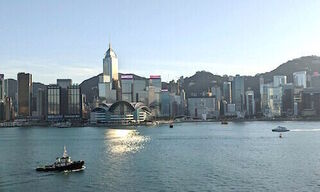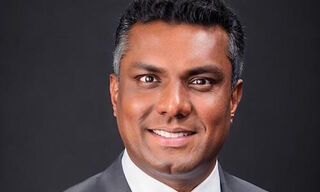The recent loosening of pandemic restrictions in large parts of the world paves the way for travel to pick up again. Todd Saligman looks at whether this will revive investor interest in the aviation industry, in a finews.first column.
This article is published on finews.first, a forum for authors specialized in economic and financial topics.
Last year was a truly awful time for global aviation. The COVID-19 pandemic brought about the biggest disruption to the global aviation industry in its entire history. Putting 2020 into historical context gives a sense of just how bad the decline in aviation volume demand was: Global air travel fell 65 percent in 2020. Before last year, the worst decline in history was 3 percent and that had occurred only three times.
Nevertheless, despite the magnitude of events, there are several reasons why some sectors within aviation, such as aircraft manufacturing, may be more resilient than they have been in the past. Aviation has been a fairly stable secular growth industry over the past four decades and the declines seen in 2020 were 20 times worse than the previous worst year in history. Given the extraordinary fall in air traffic, it’s obvious why it was such a painful year for stocks in this industry.
Structurally Different From The Past
However, what is interesting about the sharp fall in air traffic is that we didn’t see aircraft production fall to the same extent. This is especially striking given the cyclical nature of the industry, historically.
Even before the COVID-19 crisis emerged, the aerospace industry was structurally different from the past. And, despite the large declines in production rates in 2020 due to COVID-19, his view is that 2020 actually illustrated how structurally different the industry is compared to previous downturns.
Production rates in the mid-1990s and early 2000s dropped 40 percent to 50 percent when travel volumes declined only 2 percent to 3 percent in any given year. However, last year, when travel declined by a massive 65 percent, production rates fell across the industry by «only» 30 percent to 40 percent – and a big part of that was due to 737 MAX safety issues rather than COVID-19.
So, while the huge decline in traffic was still very painful, it actually showed the industry is less cyclical than it was 20 to 30 years ago. Production rates since the early 2000s have been much more stable.
1. More Diversified Demand
Demand for aircraft is much more diversified today.
- Growth and replacement demand: Historically, most aircraft deliveries were a response to industry growth. Today, it is more evenly split, with about 60 percent of new planes accounting for fleet growth and 40 percent for replacement of older planes. An important characteristic of replacement demand is that it is less cyclical than growth demand.
- Geographic demand: Previously, the industry was much more dependent on the fate of airlines in the U.S. and to some extent in Europe, but today it’s a global industry. It is, therefore, less dependent on anyone region, which also adds stability that wasn’t there in previous years.
2. Bigger Backlogs
Aircraft manufacturing is essentially a global duopoly between Airbus and Boeing. Before the crisis, the long-term structural demand for their products meant backlogs on their order books were much larger than they had been in the past.
While there has been a considerable number of unfilled orders for Boeing and Airbus because some airlines didn’t take deliveries due to the impact of COVID-19, looking at the bigger picture there are still huge backlogs and the great demand for aircraft. The size and robustness of the order books bring stability and visibility to revenues from original equipment manufacturers (OEMs).
3. Production Planning
Another difference today compared with 20 to 30 years ago is that production is now planned more cautiously.
Previously, production rates would increase very quickly in response to orders. Over the past decade, Boeing and Airbus have both been disciplined about raising production rates gradually to avoid periods of significant oversupply, which helps reduce cyclicality.
4. Period of Less Development
The industry is currently in a period of less development compared to the past. Both Boeing and Airbus have spent billions of dollars over the past 10-15 years developing new aircraft. Development projects are expensive and contain a level of risk.
But development cycles are also long, so if there were plans to launch new models before 2030, development work would already be underway. While there will likely be tweaks to current airplane models, such as adding functionality, I don't think there will be any clean sheet development programs in the near-to-medium term, certainly for Airbus.
Boeing is arguably in greater need to build a new aircraft shorter term, but whether it does or not will depend on how the company responds to the challenge it faces with its 737 MAX aircraft. Nevertheless, over the next ten years, the number of development projects will be much lower than in the past, which helps companies’ margins and returns.
5. Efficiency Gains Support Replacement Demand
An appetite for new-generation aircraft has kept order cancellations relatively low. When compared to the past two decades, 2020 doesn’t stand out as a particularly bad year in terms of order cancellations, despite the level of uncertainty.
Cancellations were a little over 1,500 globally last year, representing about 10 percent of the total order book backlog. And most of those were for Boeing aircraft (Airbus cancellations were minimal) and were likely caused by the 737 MAX safety issues.
New airplanes today are between 15 percent and 20 percent more fuel-efficient than the previous generation. That represents a two-generation leap in terms of efficiency. In the past new aircraft offered fuel efficiency improvements of about 5 percent to 8 percent on the previous model.
Fuel costs will differ depending on the airline, but these efficiency gains have a significant impact on airlines’ margins. If we use an approximation for the industry that fuel accounts for 22 percent of an airline’s costs and operating profit margins are 5 percent; assuming all other costs are constant, reducing fuel costs by 15 percent means that airlines’ profit margins improve from 5 percent to 8 percent.
This is a 60 percent increase – just by replacing older planes with newer, more fuel-efficient models. So even if airlines didn’t want to take new planes on to expand their fleets, it still makes economic sense to replace older aircraft.
Todd Saligman is an equity analyst specializing in aerospace at U.S. asset manager Capital Group.
Previous contributions: Rudi Bogni, Peter Kurer, Rolf Banz, Dieter Ruloff, Werner Vogt, Walter Wittmann, Alfred Mettler, Robert Holzach, Craig Murray, David Zollinger, Arthur Bolliger, Beat Kappeler, Chris Rowe, Stefan Gerlach, Marc Lussy, Nuno Fernandes, Richard Egger, Maurice Pedergnana, Marco Bargel, Steve Hanke, Urs Schoettli, Ursula Finsterwald, Stefan Kreuzkamp, Oliver Bussmann, Michael Benz, Albert Steck, Martin Dahinden, Thomas Fedier, Alfred Mettler, Brigitte Strebel, Mirjam Staub-Bisang, Nicolas Roth, Thorsten Polleit, Kim Iskyan, Stephen Dover, Denise Kenyon-Rouvinez, Christian Dreyer, Kinan Khadam-Al-Jame, Robert Hemmi, Anton Affentranger, Yves Mirabaud, Katharina Bart, Frédéric Papp, Hans-Martin Kraus, Gerard Guerdat, Mario Bassi, Stephen Thariyan, Dan Steinbock, Rino Borini, Bert Flossbach, Michael Hasenstab, Guido Schilling, Werner E. Rutsch, Dorte Bech Vizard, Adriano B. Lucatelli, Katharina Bart, Maya Bhandari, Jean Tirole, Hans Jakob Roth, Marco Martinelli, Thomas Sutter, Tom King, Werner Peyer, Thomas Kupfer, Peter Kurer, Arturo Bris, Frederic Papp, James Syme, Dennis Larsen, Bernd Kramer, Ralph Ebert, Armin Jans, Nicolas Roth, Hans Ulrich Jost, Patrick Hunger, Fabrizio Quirighetti, Claire Shaw, Peter Fanconi, Alex Wolf, Dan Steinbock, Patrick Scheurle, Sandro Occhilupo, Will Ballard, Nicholas Yeo, Claude-Alain Margelisch, Jean-François Hirschel, Jens Pongratz, Samuel Gerber, Philipp Weckherlin, Anne Richards, Antoni Trenchev, Benoit Barbereau, Pascal R. Bersier, Shaul Lifshitz, Klaus Breiner, Ana Botín, Martin Gilbert, Jesper Koll, Ingo Rauser, Carlo Capaul, Claude Baumann, Markus Winkler, Konrad Hummler, Thomas Steinemann, Christina Boeck, Guillaume Compeyron, Miro Zivkovic, Alexander F. Wagner, Eric Heymann, Christoph Sax, Felix Brem, Jochen Moebert, Jacques-Aurélien Marcireau, Ursula Finsterwald, Claudia Kraaz, Michel Longhini, Stefan Blum, Zsolt Kohalmi, Karin M. Klossek, Nicolas Ramelet, Søren Bjønness, Lamara von Albertini, Andreas Britt, Gilles Prince, Darren Willams, Salman Ahmed, Stephane Monier, and Peter van der Welle, Ken Orchard, Christian Gast, Jeffrey Bohn, Juergen Braunstein, Jeff Voegeli, Fiona Frick, Stefan Schneider, Matthias Hunn, Andreas Vetsch, Fabiana Fedeli, Marionna Wegenstein, Kim Fournais, Carole Millet, Ralph Ebert, Swetha Ramachandran, Brigitte Kaps, Thomas Stucki, Neil Shearing, Claude Baumann, Tom Naratil, Oliver Berger, Robert Sharps, Tobias Mueller, Florian Wicki, Jean Keller, Niels Lan Doky, Karin M. Klossek, Ralph Ebert, Johnny El Hachem, Judith Basad, Katharina Bart, Thorsten Polleit, Bernardo Brunschwiler, Peter Schmid, Karam Hinduja, Stuart Dunbar, Zsolt Kohalmi, Raphaël Surber, Santosh Brivio, Gérard Piasko, Mark Urquhart, Olivier Kessler, Bruno Capone, Peter Hody, Lars Jaeger, Andrew Isbester, Florin Baeriswyl, and Michael Bornhaeusser, Agnieszka Walorska, Thomas Mueller, Ebrahim Attarzadeh, Marcel Hostettler, Hui Zhang, Michael Bornhaeusser, Reto Jauch, Angela Agostini, Guy de Blonay, Tatjana Greil Castro, Jean-Baptiste Berthon, Marc Saint John Webb, Dietrich Goenemeyer, Mobeen Tahir, Didier Saint-Georges, Serge Tabachnik, Rolando Grandi, Vega Ibanez, Beat Wittmann, Carina Schaurte, and David Folkerts-Landau, Andreas Ita, Teodoro Cocca, Michael Welti, Mihkel Vitsur, Fabrizio Pagani, and Roman Balzan.





















